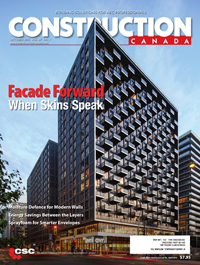The impact of modular construction on housing accessibility

Kevin Stewart, director, pursuits and projects, at ANC, spoke to Tanya Martins of Construction Canada about the Canadian Helen Keller Centre’s (CKHC) new residence and training facility, an innovative modular construction project that’s breaking ground in accessible housing for the deafblind community in Toronto.
The housing project will deliver 56 affordable and accessible homes in Toronto’s west end, providing a safe and inclusive living environment for individuals who are deafblind and others with general disabilities.
What makes this project especially newsworthy is the accelerated 12-month build timeline—nearly half the time of traditional construction—made possible through off-site fabrication and on-site parallel work.
Can you describe the specific modular design strategies or adaptations that were implemented to meet the unique accessibility needs of the deafblind community?
Custom features like contrasting finish colours, floor transitions, and barrier-free elements throughout were implemented in the modular construction just as they would in a conventional build. Steel and concrete frames gave an adaptable structural system where specific exterior, interior, and fit-out elements can be incorporated to meet the custom design needs of any project.
What challenges did you face in co-ordinating off-site fabrication with on-site construction, and how were those addressed to maintain the accelerated 12-month timeline?
Detailed design is essential to the success of a modular project. Through 3D software, ANC spent significant time detailing the interface between the on-site construction elements and the modular units. Most of the modular pieces start on level 2 and sit on a steel podium, while elevator and stairs shafts, all built in our facility, extend down to the concrete suspended slab on the ground floor.
Beyond design, the core team has decades of conventional construction experience that helps guide design decisions ahead of the fabrication phase. Schedule acceleration, in modular construction, works when the entire design is completed at once, allowing both the off-site and on-site work to happen at the same time. Foundations for this project started in late 2024, and we were in full production of modular components in the factory at the same time.
How did ANC integrate building systems into the modules to ensure compliance with accessibility and life-safety codes?
Working with Chamberlain Architects and their entire design team, we adapted the building designs into a modular solution. Each power feed, water supply line, vent, exhaust, and fire-protection element is modelled to ensure a complete, connected system in the final result.
What lessons from this project could be applied to future modular housing developments?
Speed. Modular construction delivers faster results. Developments like this one are rarely built with the intention that the spaces may get filled, but usually because there is a waitlist of people in need. If the building can be built-in almost half the time, at the same cost, with no sacrifice on quality or design, why wouldn’t this be the best option?
Once complete, the new facility will provide accessible housing and services for individuals who are deafblind, offering a fully inclusive and supportive environment in the heart of Etobicoke.




